Porcelain tableware offers a smooth, non-porous surface that is highly resistant to chipping and scratching, making it ideal for everyday use and elegant dining settings. Vitrelle combines layers of glass to create a durable, lightweight material that withstands thermal shock and is dishwasher safe, providing practicality without sacrificing style. Choosing between porcelain and Vitrelle depends on the desired balance of sophistication and durability for your tableware needs.
Table of Comparison
| Feature | Porcelain | Vitrelle |
|---|---|---|
| Material | Fired clay with kaolin | Tempered glass laminate |
| Durability | Strong but prone to chipping | Highly resistant to breakage and chipping |
| Weight | Heavier, solid feel | Lightweight and easy to handle |
| Appearance | Elegant, classic finish | Modern, translucent look |
| Heat Resistance | Good heat retention, microwave safe | Excellent heat resistance, also microwave safe |
| Price | Moderate to high | Affordable to moderate |
| Common Uses | Fine dining, formal occasions | Everyday use, casual dining |
Key Differences Between Porcelain and Vitrelle
Porcelain is a dense, non-porous ceramic known for its strength, translucency, and high resistance to chipping and heat. Vitrelle, a type of tempered glass composite used by Corelle, is lightweight, chip-resistant, and less prone to breakage due to its multi-layered glass composition. Porcelain generally offers a more refined, elegant appearance, while Vitrelle provides practical durability and versatility for everyday use.
Material Composition: Porcelain vs Vitrelle
Porcelain is composed primarily of kaolin clay fired at high temperatures, resulting in a dense, translucent material known for its durability and delicate appearance. Vitrelle, made from a combination of glass and glazed ceramic, offers enhanced strength and chip resistance while maintaining a smooth, glossy finish. Both materials provide distinct benefits in tableware, with porcelain prized for elegance and Vitrelle favored for practical, everyday use.
Durability and Strength Comparison
Porcelain offers exceptional durability due to its dense, vitrified composition, making it resistant to chips and cracks from everyday use. Vitrelle, a tempered glass composite, combines strength with lightweight features and exhibits superior resistance to thermal shock and breakage. Both materials provide robust tableware options, with porcelain excelling in hardness and vitrelle in impact resistance and weight management.
Aesthetic Appeal and Design Options
Porcelain offers a classic, translucent finish known for its delicate and refined appearance, making it ideal for elegant, traditional table settings. Vitrelle, composed of tempered glass layers, provides a modern, sleek look with the opportunity for vibrant colors and intricate patterns, enhancing contemporary dining aesthetics. Both materials present diverse design options, but porcelain emphasizes timeless beauty while Vitrelle excels in versatility and bold visual statements.
Weight and Handling: Which Is Lighter?
Porcelain tableware typically weighs less than Vitrelle due to its fine, dense composition, offering a lighter and more delicate feel during handling. Vitrelle, a tempered glass laminate, is heavier and more robust, providing greater durability but less ease of use in terms of weight. For users prioritizing lightweight and elegant tableware, porcelain is generally the preferred choice.
Heat Resistance and Microwave Safety
Porcelain offers excellent heat resistance, tolerating high temperatures without cracking, making it safe for microwave use. Vitrelle, a tempered glass composite, also provides strong heat resistance and is microwave safe, but it heats unevenly compared to porcelain. Both materials are durable choices for tableware with microwave safety, yet porcelain excels in maintaining structural integrity under frequent temperature changes.
Ease of Cleaning and Maintenance
Porcelain tableware features a smooth, non-porous surface that resists staining and is dishwasher safe, making it easy to clean and maintain. Vitrelle, a tempered glass composite, offers excellent durability and resists scratches and chipping, simplifying upkeep while retaining a glossy finish. Both materials provide hassle-free maintenance, but porcelain's sealed surface generally requires less frequent deep cleaning compared to Vitrelle.
Price Comparison: Porcelain vs Vitrelle
Porcelain tableware typically commands a higher price due to its refined craftsmanship, durability, and elegant finish, making it a premium choice for formal dining. Vitrelle, made from tempered glass, offers a more affordable yet resilient alternative with a lighter weight and chip-resistant properties, appealing to everyday use. Price comparisons reveal porcelain sets often range from $50 to $200+, while Vitrelle options frequently cost between $30 and $100, balancing cost with practicality.
Best Uses: Everyday Dining or Special Occasions
Porcelain excels in special occasions due to its elegant, translucent quality and resistance to chipping, making it ideal for formal dining settings. Vitrelle, known for its durability and chip-resistant properties, is perfect for everyday dining as it withstands heavy use and frequent washing. Choosing between porcelain and Vitrelle depends on the balance between aesthetic appeal and practical durability suited to your dining needs.
Choosing the Right Tableware for Your Home
Porcelain offers a classic, elegant aesthetic with high durability and resistance to chipping, making it ideal for formal dining settings and everyday use. Vitrelle, a tempered glass composite used in Corelle products, is lightweight, impact-resistant, and microwave-safe, perfect for casual meals and family-friendly environments. Selecting between porcelain and Vitrelle depends on your lifestyle needs, prioritizing either sophistication and longevity or practicality and ease of care.
Porcelain vs Vitrelle Infographic

 productdif.com
productdif.com